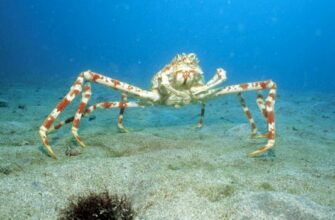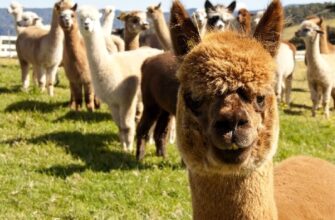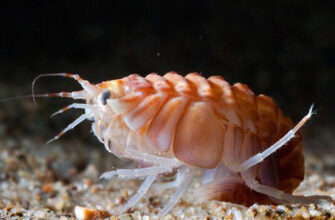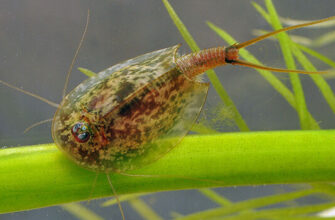King crab is also called the King crab due to its impressive size. The benthic marine life is interesting as a biological species, it is also of interest from an economic point of view, since it is an object for commercial catch. The habitat is wide. King crab — one of the few zoo-representatives that has successfully passed the process of artificial relocation.
Origin and description of the species
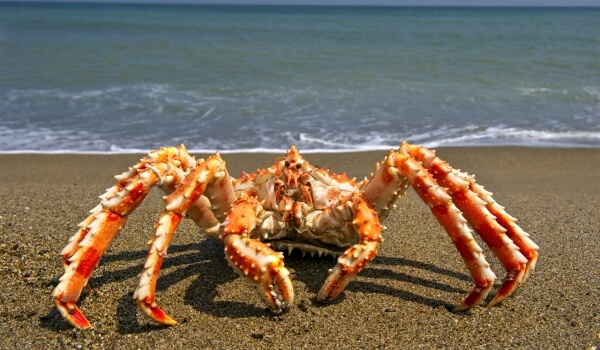
Photo: King crab
The name of the king crab (Paralithodes camtschaticus) is due to its resemblance to crabs, but according to zoological classification it evolved from hermit crabs belonging to the Craboid family, the common genus Paralithodes.
The main difference from crabs is the fifth pair of walking legs shortened and hidden under the shell, as well as an irregularly shaped, with chitinous shields, an asymmetric abdomen in females. A short pair of limbs in hermit crabs serves to hold the shell. In the process of evolution, the Kamchatka crab ceased to live in the shell and therefore the need to hold it disappeared. The fifth pair of legs is used to clean the gills.
The crab moves with the help of four pairs of limbs, moving them in turn. Moves at a fairly high speed, the direction of movement in this species is to the side.
On the abdomen, bent and shortened, there are small plates and micropedia, the asymmetric arrangement of which confirms the origin of the arthropod from species in which the abdomen is twisted in a spiral shape.
Video: Kamchatka crab
The senses of touch and smell are provided by the front antennas with sensitive cylinders located on them. This species feature has a significant impact on feeding behavior, helping in the search and selection of food.
As the individual grows, the frame skeleton, or molt, changes. The frequency of molting at the beginning of life, especially during the development of larvae, is high and occurs much less frequently, up to 1-2 per year in an adult, and by the end of life it happens only once every two years. How often crabs should shed is regulated by special glands located on the eye stalks. Before discarding the old frame, the soft parts of the arthropod are already covered with a still weak, pliable shell. King crab lives on average about 20 years.
Appearance and features
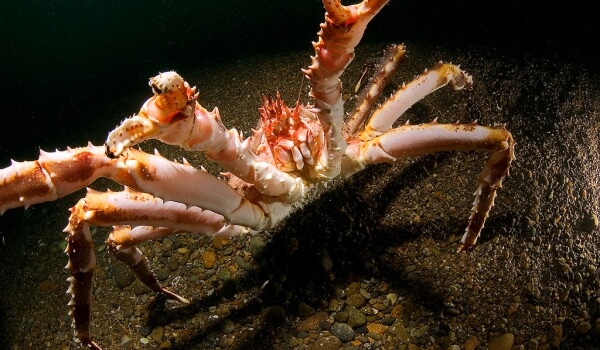
Photo: Live King Crab
The body of the crab consists of two parts — the cephalothorax, which is under the protective shell and the abdomen, bent under the cephalothorax. The eyes are protected by an overhanging armored roller or beak. The carpace has sharp protective spike-like needles, 6 of which are located above the heart and 11 above the stomach area.
In addition to the protective function, the shell also performs the function of a support and an exoskeleton, because muscle fibers are attached to it from the inside, which carry out movements. On the side surfaces of the frame shell are the respiratory organs — gills. The nervous system is represented by a chain of interconnected nerve nodes located on the underside of the cephalothorax and abdomen. The heart is at the back, and the stomach is located at the head.
Of the five pairs of legs, the crab uses only four to move. The reduced fifth pair is hidden under the shell and is used to cleanse the gills.
Interesting fact. The use of claws in the king crab differs in the nature of the function performed. With its left claw, the crab cuts softer food, and with its right claw it crushes hard food — sea urchins living at the bottom, shells of various molluscs. The claws differ in size, the larger one is the right one, which performs harder work.
In males, the width of the body varies from 16 to 25 cm and the weight reaches 7 kg. About 1.5 m is the distance between the ends of the long legs in the largest individuals. Females are smaller — body up to 16 cm, weight on average 4 kg. The female is also distinguished by the presence of a round and irregularly shaped abdomen.
The color of the shell of the king crab is red with a brown tint on top, patches and blotches in the form of purple spots are noted on the lateral surfaces, the color of the crab is lighter below — from white to yellowish.
Where does the king crab live?
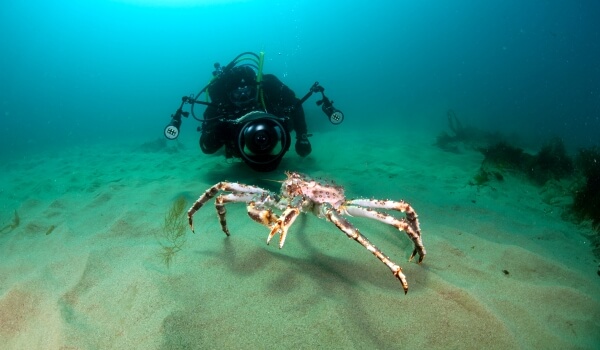
Photo: Large king crab
Wide distribution noted in the northern part of the Pacific Ocean, where arthropods of this species are more abundantly found in the Kamchatka region in the Sea of Okhotsk, as well as in the Bering Sea. The crab also lives off the American coast in Bristol Bay, Norton Bay and near the Aleutian Islands. In the Sea of Japan, habitat is noted from the south side.
Interesting fact. Biologists of the Soviet Union developed and implemented the relocation of the species to the Barents Sea.
The new environmental conditions are different from the usual conditions of natural habitat (lower salinity, temperature ranges, annual temperature change). The process of theoretical training has been going on since 1932, induced by the main goal — achieve economic profit from fishing in their waters, avoiding high competition from Japan and other countries.
The first attempts to transport crabs were carried out by rail and were unsuccessful — all individuals died, the travel time was long, taking more than 10 days. After that, in the 60s, air transportation was carried out, taking a short time. So the first batches of arthropods were delivered and acclimatized. Later, in the 70s, transportation took place in specially equipped wagons and was the most successful.
At present, as a result of the process of invasion in the North Atlantic, an independent population unit with a high replenishing and self-regulating population has formed. There is an industrial catch of large males. Catching of juveniles and females is prohibited.
What does the king crab eat?
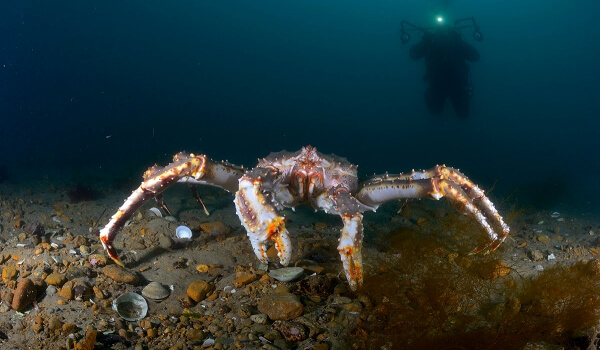
Photo: King crab
Food for this species is very diverse and the crab is essentially an omnivorous predator.
p>
Food objects are all inhabitants of the seabed:
- various mollusks;
- plankton;
- worms;
- sea urchins;
- crustaceans;
- squirts;
- small fish;
- starfish.
Young animals feed on:
- algae;
- hydroid organisms;
- worms.
During their life, representatives of this species make mass movements for food purposes. Moving from one ecosystem to another, the dominant species in a particular system become food.
Powerful claws serve as an excellent tool, and the crab easily obtains the necessary food. Moreover, killing the victim, the crab does not eat it completely, and most of its mass disappears. Crabs also eat the cadaveric remains of fish and other marine organisms, acting as a purifier of water expanses. After the introduction of the crab into the waters of the northern seas, there is still no unambiguous opinion about the influence of the migrant on the local biosystems as a whole.
Some scientists criticize the experiment, fearing for the presence and abundance of native species of inhabitants of the northern seas, with which the Kamchatka crab competes in food needs and feeds on them. After all, eating massively certain types of organisms, the crab can lead to their depletion and even extinction. Other scientists commend the results of the introduction, emphasizing the economic benefits.
Interesting fact. At different periods of their life cycle, arthropods prefer different foods. For example, an individual that will molt in the near future prefers to eat organisms with a high calcium content, such as echinoderms.
Character and lifestyle features
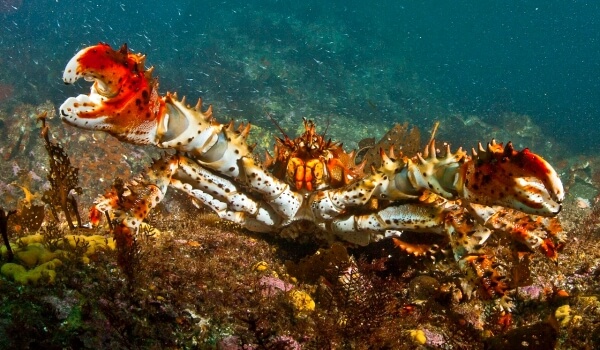
Photo: King Crab
The strong frame of the arthropod, while serving as protection and support, at the same time prevents growth between the moments of its change. The animal grows only in a short period (usually no more than 3 days), when the old solid frame is dropped, and the new, still soft and supple, does not prevent it from rapidly increasing in size. After a growth spurt, the chitin cover is intensively impregnated with calcium salts and general growth stops until the next molt.
The frequency of shell change varies with the course of life:
- up to 12 times after the formation of the larva during years;
- up to 7 times, already less often in the second year of life;
- 2 times during the year during the period of life from the third to the ninth year of an individual's life;
- 1 time from the ninth to the twelfth years of life;
- 1 time in two years, starting from the age of thirteen and until the end of his life.
During the molt, the animal tries to find shelter in depressions or rock crevices, as it becomes defenseless without a solid framework.
Interesting fact. Moulting affects not only the outer cover of the crab, there is also a renewal of the internal organs — the membranes are renewed in the esophagus, stomach and intestines. The ligaments and tendons by which the muscle fibers are attached to the exoskeleton are also subject to renewal. Cardiac tissues are also renewed.
A representative of this species is a rather active arthropod, constantly making migratory movements. The route of movement does not change, repeating annually again. The reason for migration is the seasonal change in water temperature and the availability of food, as well as the instinct of reproduction.
So, with the onset of winter, the crab descends along the bottom into deep waters within 200-270 m. With warming, it returns to shallow waters that are warm and filled with food. Crabs migrate en masse, gathering in groups with different numbers. Males are ready to breed when they are ten years old and females are seven or eight years old.
Social Structure and Reproduction
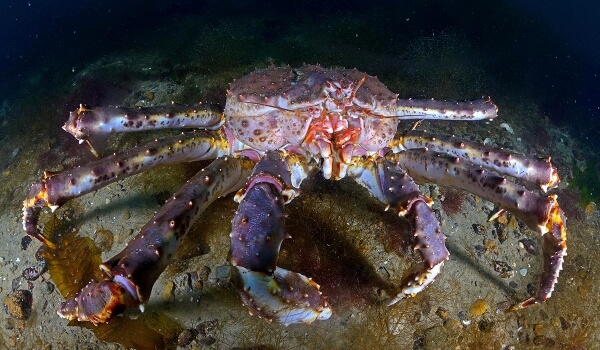
Photo: Sea king crab
After the onset of spring , males begin their journey to shallow water. Females move in the same direction, but in separate groups. The female carries already ripened eggs on the legs located near the abdomen. Closer to shallow water, larvae appear from the eggs and are carried away by the current. By this time, a new caviar has already been formed in the genitals of the female, which is just about to be fertilized.
With the onset of molting, individuals of both sexes approach each other and form a characteristic posture — the male holds the female with both claws, resembling a handshake. The retention continues until the end of the molt, sometimes the male helps the chosen one to get rid of the old frame. After the molt is completed (on average, from three to seven days), the male ejects a tape with sex cells — spermatophore, which is fixed on the legs of the female. The male, having completed the mission, is removed and also molts.
After some time (from several hours to several days), the female spawns eggs (from 50 to 500 thousand), which, meeting with the male's ribbon, are fertilized. A special sticky substance collects the eggs together and attaches them to the villi on the female's ventral legs, where they go through a cycle of development until next spring, for 11 months. The female spawns only once a year, in spring, while males can carry out the mating process with several females.
The larvae that have just hatched from the eggs are in the water column for about two months and are carried by the current; at this stage of development, up to 96% of the larvae die. After the surviving larvae sink to the bottom, into the thickets of algae, where they live for three years. They often molt, go through several stages of development. Then the juveniles move to the bottom platforms of a sandy nature. Migration begins after reaching the age of 5, sometimes 7 years.
Natural enemies of king crabs
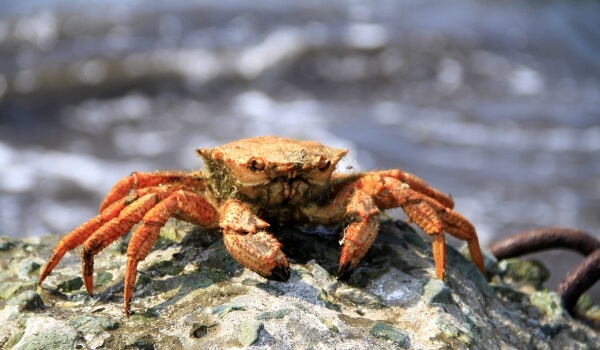
Photo: King Crab
There are few natural enemies in adult large representatives of the species, since the crab has excellent protection — a reliable and durable shell, which in addition is covered with sharp spike-like needles. Only large marine mammals are able to overpower an adult crab.
Smaller individuals have more enemies, among them:
- predatory fish;
- Pacific cod ;
- halibut;
- sea otter;
- gobies;
- octopuses;
- crabs of large sizes, various species (intraspecific cannibalism is noted).
During the molting period, the crab becomes completely vulnerable and is forced to seek shelter. Man does not belong to the natural enemies of the species, however, given the uncontrolled commercial catch, poaching catches, a person has every chance of becoming a species enemy. Therefore, at the state level, quotas for catching the royal arthropod are determined in order to use the population reserves as carefully as possible, without undermining their numbers and ability to recover.
Human activity indirectly negatively affects marine life, in particular the Kamchatka crab. Industrial chemical waste, plastic, oil products pollute the expanses of the seas and oceans, negatively affecting the entire flora and fauna. As a result, entire species are depleted or on the verge of extinction.
Population and species status
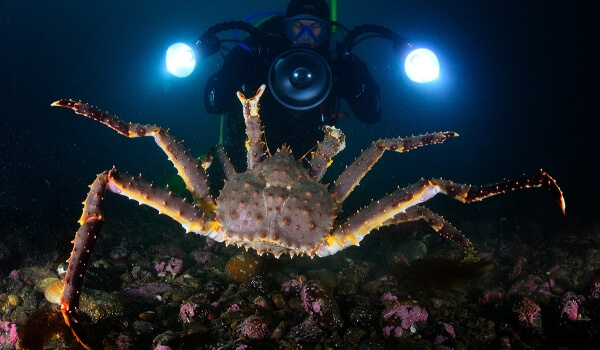
Photo: Large king crab
The migration of the king crab occurs in groups of individuals, while females and males move separately, meeting only once a year, in spring, for mating. Juveniles also move separately, creating groups of young. The crab population in the Kamchatka region is currently significantly reduced, for the same reasons of large-scale and uncontrolled commercial fishing.
In the Barents Sea, where artificial introduction of the species took place, the situation is opposite. Due to the absence of many natural enemies that regulate the population, the royal arthropod quickly spread throughout the coastal territory of the Barents Sea. According to rough estimates, the population in 2006 was more than 100 million individuals and continues to grow.
The polyphagous predator quickly exterminates the native species of many crustaceans, mollusks and others, which rightly raises concerns for the continued existence of a stable ecosystem in the Barents Sea many biologists.
Since 2004, Russia has begun to produce commercial catch. Permissible fishing volumes are determined every year based on the current situation in the estimated population size.
King crab is an interesting arthropod, with a special development cycle. Representatives of this species have successfully passed the process of introduction and acclimatization in the northern Barents Sea. How this introduction will affect the integrity of the marine ecosystem in the future, scientists predict in different ways.

